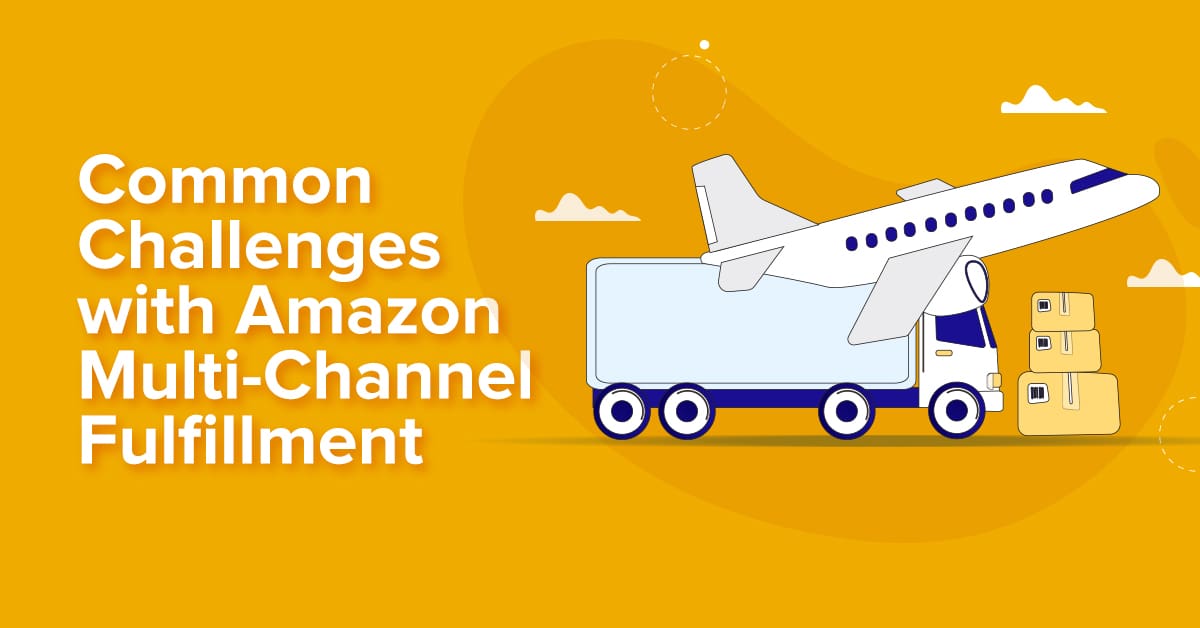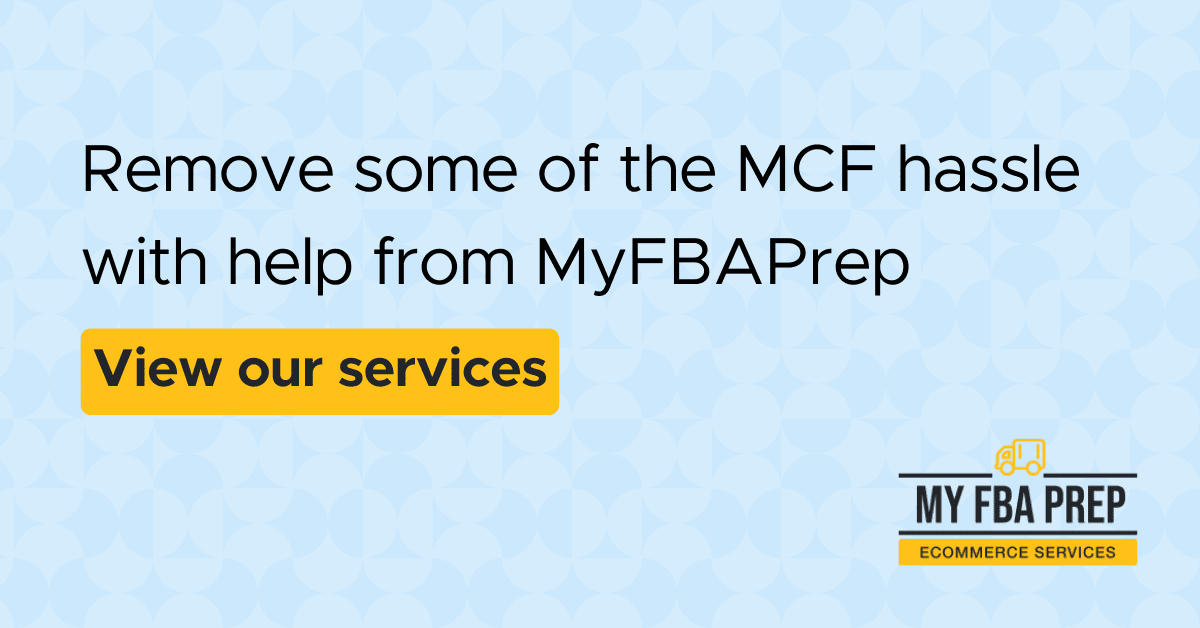
Common Challenges With Amazon MCF & How to Overcome Them

Amazon is a major player in the eCommerce industry, providing online sellers with a massive platform to reach millions of customers across the globe. One of its most popular services is Amazon Multi-Channel Fulfillment (MCF), which allows sellers to take advantage of Amazon’s vast fulfillment network to complete orders from other sales channels.
Amazon MCF helps merchants streamline their fulfillment processes and improve customer satisfaction. However, like any eCommerce service, it also comes with a set of challenges that can impact a seller’s bottom line, reputation, and overall operations.
In this article, we’ll explore some of the most common obstacles sellers face with Amazon MCF and provide tips on how to navigate and overcome them. By understanding these challenges and implementing best practices, you can effectively leverage the power of Amazon MCF to improve your operations, boost customer satisfaction, and increase profitability.
Common MCF challenges
These are common issues merchants encounter when using Amazon MCF:
- High costs: One of the biggest challenges with Amazon MCF is its high service cost. Amazon charges fees for storage, handling, and shipping, and these expenses can add up quickly, particularly for sellers with large or heavy items. Additionally, the cost structure for MCF can be complex, making it challenging to calculate costs and profit margins accurately.
- Limited inventory visibility: Amazon MCF provides limited visibility into inventory levels and locations, making it difficult for sellers to manage their stock efficiently. This can lead to overstocking or understocking, which in turn can result in lost sales or wasted inventory.
- Shipping delays: Although Amazon has an extensive fulfillment network, shipping delays can occur due to a variety of factors, such as natural disasters, weather conditions, or other unforeseen events. Such delays can negatively impact a seller’s reputation and customer satisfaction, particularly if the merchant fails to provide accurate tracking information or timely updates.
- Limited customization options: Amazon MCF offers limited customization options for packaging and branding, which makes it challenging for sellers to differentiate their brand and create a unique customer experience. This is a major drawback in crowded markets or for merchants with highly personalized products.
- Poor customer service: Some sellers have reported issues with Amazon’s customer service, including slow response times and a lack of personalized support. This can be frustrating, especially if merchants encounter issues with their MCF orders or need assistance navigating the platform.
Overcoming these challenges
Despite these issues, there are several strategies sellers can use to overcome them:
- Negotiate rates with Amazon: To reduce MCF costs, you can negotiate rates. This involves working with Amazon’s customer support team or using an Amazon-approved third-party service to explore opportunities to reduce fees and optimize fulfillment costs. Additionally, Amazon provides a fee calculator to estimate your costs and identify areas to cut expenses.
- Adopt inventory management software: To manage inventory levels more effectively, look for inventory management software that integrates with MCF. These tools provide real-time visibility into your inventory levels and locations, which helps optimize your inventory levels and avoid stockouts. Some inventory management software can also automate inventory forecasting and replenishment so you can stay on top of your inventory needs more easily.
- Work with third-party logistics providers: To improve shipping times and lower fulfillment costs, consider working with a third-party logistics provider (3PL). 3PLs can provide additional warehousing and fulfillment support to expand your reach and reduce shipping costs. By leveraging a 3PL’s expertise and infrastructure, you’ll enjoy the benefit of their fulfillment speed and accuracy while freeing up resources to focus on other aspects of your business.
- Maintain open communication: When shipping delays and other issues inevitably occur, communicate the situation to your customers. This includes providing accurate tracking information, sending automated updates, and offering clear and timely responses to their inquiries. You can also leverage Amazon’s built-in communication tools, such as messaging and feedback, to stay in touch and address any issues or concerns.
- Provide excellent customer service: To maintain customer satisfaction and avoid the headache of Amazon’s customer service, provide your own exceptional customer support. Similar to the previous point, clear and timely communication, accurate product information, and addressing customer concerns promptly are important components here as well. By catering to consumer needs, you’ll improve your reputation and drive repeat business.
Implement these strategies and stay proactive in managing your MCF operations to maximize its benefits for your business and achieve long-term success.
Best practices for Amazon MCF
To optimize your use of Amazon MCF, here are some of the most effective best practices to follow:
- Streamline your fulfillment process: This can involve refining your packaging, labeling, and shipping procedures, as well as using automated tools and software to manage orders and inventory. By streamlining your fulfillment process, you reduce errors and speed up shipping times.
- Implement quality control measures: Quality control measures ensure your products are delivered to customers in good condition. You can employ secure and reliable packaging materials, perform quality checks on products before they ship, and track products throughout the fulfillment process to identify potential issues. These actions lower the risk of returns, improve customer satisfaction, and protect your reputation.
- Stay on top of Amazon’s rules and policies: Amazon has strict rules and policies for sellers who use their fulfillment services. They cover everything from product packaging and labeling to shipping methods and handling procedures. To avoid penalties and maintain smooth operations, make sure you learn and follow these regulations.
- Take advantage of Amazon’s technology: Amazon MCF offers numerous tools and resources designed to help sellers optimize their fulfillment. These include automated order processing and inventory tracking, advanced analytics, reporting tools, and more. Take advantage of these resources to gain valuable insights into your business and make informed decisions to strengthen its functionality.
- Partner with third-party experts: Realize the full potential of Amazon MCF by partnering with third-party vendors who can streamline your business. Vendors like MyFBAPrep can provide additional warehousing and fulfillment support, helping you expand your reach and cut shipping costs. Additionally, many offer specialized services like kitting and bundling so you can create unique product offerings and stand out in a crowded market.
- Monitor and optimize your performance: Regularly measure your Amazon MCF performance and make adjustments where needed. This entails analyzing your shipping and fulfillment metrics and tracking your inventory levels. Stay on top of your performance metrics to identify issues and opportunities to improve your fulfillment.
Following these best practices and proactively managing your Amazon MCF operations will help you optimize your business operations, reduce costs, and improve customer satisfaction.
Wrapping up — Work smart, not hard with Amazon MCF
Amazon Multi-Channel Fulfillment offers numerous benefits to eCommerce sellers, allowing them to expand their reach, improve their customer satisfaction, and streamline their fulfillment operations. However, the service has its drawbacks, like high costs, restricted inventory visibility, shipping delays, limited customization options, and poor customer service. However, you can overcome these challenges by implementing strategies like negotiating rates with Amazon, utilizing inventory management software, working with 3PLs, communicating with buyers, and providing excellent customer service.
Follow these best practices, and you’ll make the most of Amazon MCF while reducing costs, improving operations, and driving long-term success for your eCommerce business. You’ll also stay informed on changes to the platform and identify opportunities to optimize your fulfillment operations.


